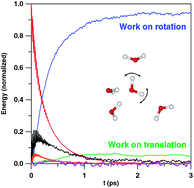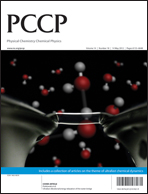Tracking energy transfer from excited to accepting modes: application to water bend vibrational relaxation†
Abstract
We extend, via a reformulation in terms of Poisson brackets, the method developed previously (Rey et al., J. Phys. Chem. A, 2009, 113, 8949) allowing analysis of the pathways of an excited molecule's ultrafast vibrational relaxation in terms of intramolecular and intermolecular contributions. In particular we show how to ascertain, through the computation of power and work, which portion of an initial excess molecular energy (e.g. vibrational) is transferred to various degrees of freedom (e.g. rotational, translational) of the excited molecule itself and its neighbors. The particular case of bend excess energy relaxation in pure

- This article is part of the themed collection: Ultrafast chemical dynamics

 Please wait while we load your content...
Please wait while we load your content...